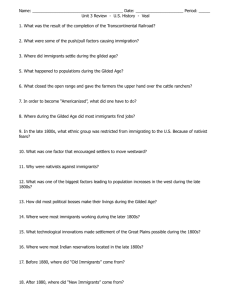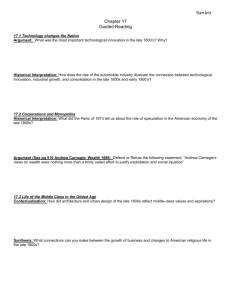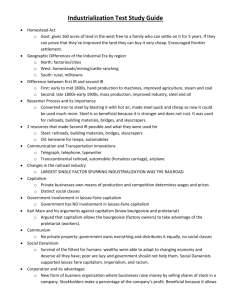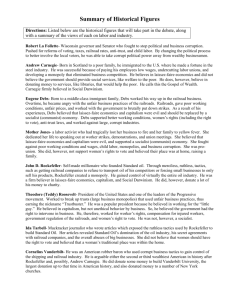Industrial Revolution 44 - White Plains Public Schools
advertisement
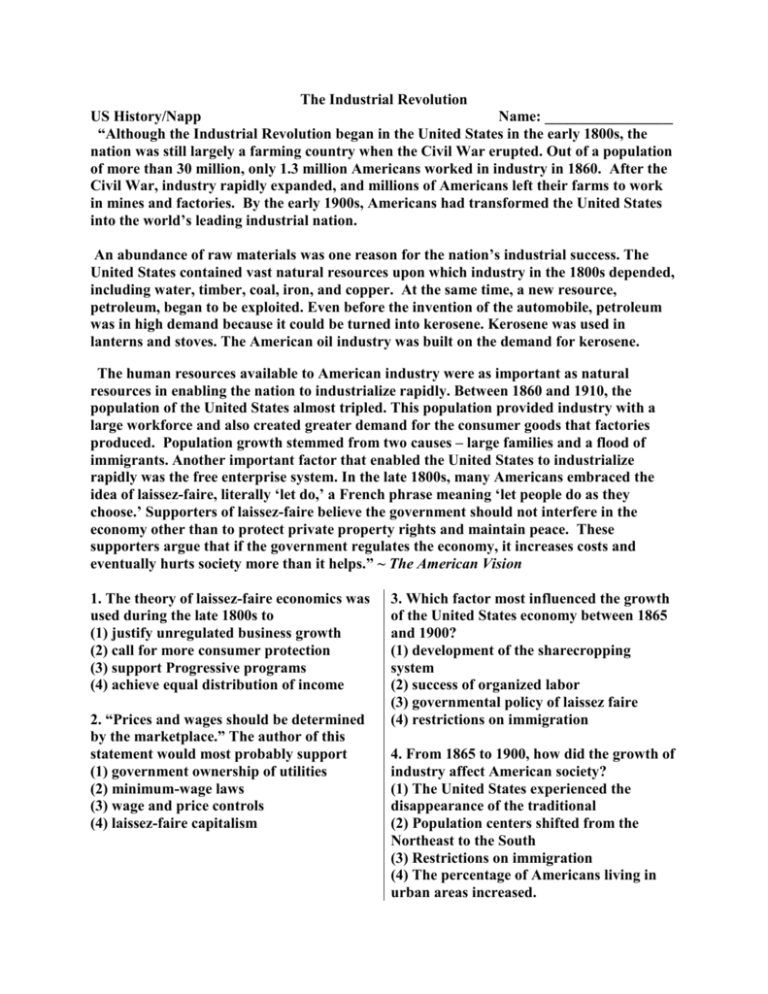
The Industrial Revolution US History/Napp Name: _________________ “Although the Industrial Revolution began in the United States in the early 1800s, the nation was still largely a farming country when the Civil War erupted. Out of a population of more than 30 million, only 1.3 million Americans worked in industry in 1860. After the Civil War, industry rapidly expanded, and millions of Americans left their farms to work in mines and factories. By the early 1900s, Americans had transformed the United States into the world’s leading industrial nation. An abundance of raw materials was one reason for the nation’s industrial success. The United States contained vast natural resources upon which industry in the 1800s depended, including water, timber, coal, iron, and copper. At the same time, a new resource, petroleum, began to be exploited. Even before the invention of the automobile, petroleum was in high demand because it could be turned into kerosene. Kerosene was used in lanterns and stoves. The American oil industry was built on the demand for kerosene. The human resources available to American industry were as important as natural resources in enabling the nation to industrialize rapidly. Between 1860 and 1910, the population of the United States almost tripled. This population provided industry with a large workforce and also created greater demand for the consumer goods that factories produced. Population growth stemmed from two causes – large families and a flood of immigrants. Another important factor that enabled the United States to industrialize rapidly was the free enterprise system. In the late 1800s, many Americans embraced the idea of laissez-faire, literally ‘let do,’ a French phrase meaning ‘let people do as they choose.’ Supporters of laissez-faire believe the government should not interfere in the economy other than to protect private property rights and maintain peace. These supporters argue that if the government regulates the economy, it increases costs and eventually hurts society more than it helps.” ~ The American Vision 1. The theory of laissez-faire economics was used during the late 1800s to (1) justify unregulated business growth (2) call for more consumer protection (3) support Progressive programs (4) achieve equal distribution of income 2. “Prices and wages should be determined by the marketplace.” The author of this statement would most probably support (1) government ownership of utilities (2) minimum-wage laws (3) wage and price controls (4) laissez-faire capitalism 3. Which factor most influenced the growth of the United States economy between 1865 and 1900? (1) development of the sharecropping system (2) success of organized labor (3) governmental policy of laissez faire (4) restrictions on immigration 4. From 1865 to 1900, how did the growth of industry affect American society? (1) The United States experienced the disappearance of the traditional (2) Population centers shifted from the Northeast to the South (3) Restrictions on immigration (4) The percentage of Americans living in urban areas increased. More Factors for Industrialization in the United States: I. The Expansion of Railroads A) The first transcontinental railroad, linking the east and west coasts, was completed in 1869 B) The amount of railroad track increased fivefold in the next 25 years C) Railroads connected raw materials to factories and factories to consumers D) Also promoted the settlement of the frontier E) Irish and Chinese immigrants were used as cheap labor for railroad construction II. Technological Progress: A) New inventions and technologies fueled economic expansion in the late 19th century. B) The Bessemer process made the production of steel more economical. III. The Corporation: A) Before the Civil War, most businesses were owned by individuals or partnerships. B) Following the Civil War, the corporate form of business became more popular. 1- A corporation is a company chartered by a state and recognized in law as a separate “person” 2- A corporation issues shares to investors, making each stockholder one of its partial owners Multiple-Choice Questions: 1. After the Civil War, one way 3. Many reformers who opposed the laissezbusiness leaders tried to eliminate faire attitude of the late 19th century argued competition was by (1) the National Government should not (1) forming monopolies or trusts interfere in the activities of big business (2) developing overseas markets (2) national wealth could best be assured by (3) increasing the prices of their the accumulation of gold products (3) the idea of rugged individualism is vital (4) paying high wages to their to the nation’s economic growth workers (4) government should protect society through the regulation of business th 2. During the latter half of the 19 century, many business organizations 4. Why did the United States follow a policy in the United States combined into of unrestricted immigration for Europeans large corporations because during most of the 1800’s? (1) income levels for workers would (1) Business and industry depended on the be improved foreign capital brought by immigrants. (2) government intervention in (2) The American economy needed many economic affairs would decline unskilled workers. (3) efficiency in production methods (3) Most Americans desired a more could be increased diversified culture. (4) economic possibilities outside the (4) The United States wanted to help United States could be explored European nations by taking in their surplus population. 5. Prior to 1880, the number of immigrants to the United States was not restricted mainly because (1) industry owners wanted cheap labor (2) the nations of Europe discouraged emigration (3) the United States birthrate was increasing (4) Congress lacked the power to limit immigration 6. Laws requiring individuals to pass civil service examinations to obtain government jobs were enacted to (1) eliminate patronage and corruption in government hiring (2) allow the government to compete with private industry for employees (3) support the development of public employee labor unions (4) encourage the growth of local political parties 7. In the United States during the late 19th century, much of the prejudice expressed toward immigrants was based on the belief that they would (1) cause overcrowding in farm areas (2) refuse to become citizens (3) support the enemies of the United States in wartime (4) fail to assimilate into American society 8. Which situation brought about the rapid growth of industry between 1865 and 1900? (1) high worker morale resulting from good wages and working conditions (2) availability of investment capital (3) establishment of western reservations for Native American Indians (4) decline in the number of people attending schools 9. In the decades after the Civil War, the major result of the shift from single proprietorship to corporate organization was that business was able to (1) make more efficient use of natural resources (2) concentrate on improving the quality of manufactured goods (3) provide workers with higher wages (4) raise large sums of money 10. Industrialists of the late 1800s contributed most to economic growth by (1) supporting the efforts of labor unions (2) establishing large corporations (3) encouraging government ownership of banks (4) opposing protective tariffs 11. One factor that furthered industrialization in the United States between 1865 and 1900 was the (1) development of the airplane (2) expansion of the railroads (3) mass production of automobiles (4) widespread use of steamboats Define the following terms: Monopoly: ____________________________________________________________ Laissez-Faire: _________________________________________________________ Industrial Revolution: __________________________________________________ Transcontinental Railroad: ______________________________________________ Natural Resources: _____________________________________________________ Entrepreneur: _________________________________________________________ Labor and Capital: _____________________________________________________ 12. Which 19th-century business practice does this cartoon illustrate? (1) forming cooperatives (2) establishing trade zones (3) creating monopolies (4) expanding global markets 13. The cartoonist would most likely support federal government attempts to (1) pass antitrust legislation (2) limit regulation of business (3) establish high tariffs (4) stop industrial pollution 14. Which generalization about population growth is supported by information in this chart? (1) (2) (3) (4) For every census listed, rural population exceeded urban population. By 1920, more people lived in cities than in rural areas. The Civil War significantly slowed the rate of population growth. Most urban population growth was due to people migrating from rural areas.
